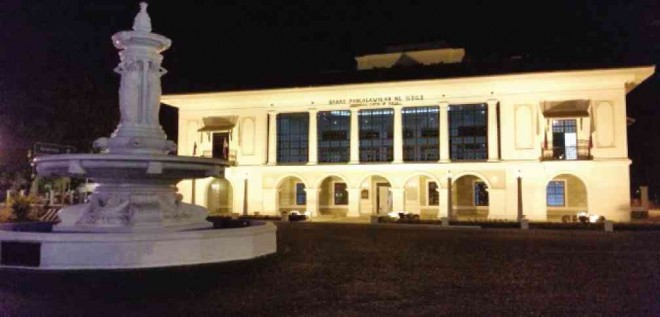Iloilo’s 2 roles in the revolution

BRIGHT CAPITOL The provincial capitol of Iloilo province is awash with lights that put the restored building in the spotlight. NESTOR P. BURGOS/INQUIRER VISAYAS
When the Philippine Revolution flared up near Manila in August 1896, the elite leaders in Iloilo reacted quickly. But instead of joining the revolt, they supported the colonial government.
The officials of Iloilo City, Jaro City and several towns passed resolutions condemning the rebellion and pledging loyalty to Spain.
The Ilonggo elite went a step farther. They organized a battalion of 500 soldiers to fight for the colonial government.
After four months of crash training, the Batallon de Voluntarios Ilonggos was shipped to Manila, landing there on
Jan. 16, 1897. For almost a year, the Voluntarios Ilonggos fought with Spanish troops against the Katipunan army of Gen. Emilio Aguinaldo.
Article continues after this advertisementThe Pact of Biak-na-Bato in December 1897 ended the first phase of the revolution. The Voluntarios Ilonggos returned to Iloilo and were received like a victorious Roman Legion.
Article continues after this advertisementThe Ilonggos did not join the revolution in 1896 because they were enjoying unprecedented prosperity. Iloilo was then the richest province and Iloilo City was second to Manila.
Wealth without freedom
The Ilonggos were enjoying the good life but soon they realized that prosperity without freedom was not enough. In March 1898, a Revolutionary Committee was formed in Molo by Francisco Villanueva, Pablo Araneta and several other leading persons to plan for the revolution.
On May 1, 1898, Commodore George Dewey of the US Navy destroyed the Spanish armada in Manila. The Spanish-American War that had earlier started in Cuba reached the Philippines. A few days later, General Aguinaldo returned from Hong Kong and launched Phase 2 of the revolution.
Facing new threats, Governor General Basilio Augustin issued a decree to organize volunteer militia units in the provinces to augment government forces. In Iloilo, the revolutionary leaders organized volunteer companies in several towns.
After Manila had fallen to the Americans on Aug. 13, 1898, the Spaniards made Iloilo City the new capital of the country. General Diego de los Rios was named governor general.
The Spaniards never doubted the loyalty of the Ilonggos so General Rios did not hesitate to arm the new Iloilo Voluntarios.
The Spaniards were therefore totally surprised when rebel forces staged simultaneous uprisings in many towns. The voluntarios had turned revolucionarios.
Liberation
Within a few days the Ejercito Libertador, as the Ilonggo leaders called their army, had liberated the whole province except Iloilo City and the neighboring Jaro, La Paz and Molo.
Assured of ultimate victory, the Ilonggo leaders convened in Sta. Barbara on Nov. 17, 1898. After attending a Te Deum Mass at the town church, the leaders went to the nearby stone house of Vicente Bermejo where they organized the Gobierno Provisional Revolucionario de Bisayas.
Roque Lopez was elected president. All the officials of the new government were prominent personalities and professionals.
A very dramatic event followed the organization of the Revolutionary Government—the raising of the Philippine flag. A bamboo flagpole was erected in front of the Bermejo house. Before it stood a regiment of the Ejercito Libertador. Behind the regiment on the wide town plaza was a large crowd that had come from many places to witness the historic event.
General Martin Delgado, the general in chief of the army, went near the pole facing the crowd and at his signal the Posidio Delgado Band played the national hymn. Two soldiers raised the Philippine flag. As the flag reached the top and flew in the breeze, the crowd broke in a loud cheer.
Delgado gave a brief charge to the soldiers telling them to fight boldly for the flag. Then he led the crowd shout, “Viva Independencia! Fuera Espana! Viva Libertad!”
This event is reenacted every year in the Kahilwayan (Freedom) Festival of Sta. Barbara.
As expected by the Ilonggo leaders, Governor General Rios began to negotiate for peace. First he gave up Jaro and concentrated his forces in Iloilo City. Finally, on Dec. 24, he surrendered the city and sailed away to Zamboanga enroute to Spain.
Glorious day
Dec. 25, 1898, was the most glorious Christmas Day in Iloilo. Early that morning, the Liberating Army led by General Delgado staged a triumphal parade into Iloilo City, Spain’s last capital in the Philippines.
Resplendent in their uniform and fully armed, the Liberating Army marched to the beat of “Marcha Libertador” composed by Col. Posidio Delgado and played by the famous Banda del Regimento-72.
Thousands of people crowded both sides of Calle Real to see the parade. Most were crying with joy, shouting “Viva Independencia! Viva Libertad!”
The triumphal march ended at Plaza Alfonso XII (now Plaza Libertad) in front of the Ayuntamiento of Iloilo City. There the revolutionists again raised the Philippine flag to fly over Spain’s last capital in las Islas Filipinas.
(Editor’s Note: Demy P. Sonza is a former vice governor and incumbent provincial board member of Iloilo. He has authored a collection of poems, biographies and various books on history including “Mightier than the Sword: Biography of Graciano Lopez-Jaena,” “Sugar is Sweet: The Story of Nicholas Loney,” “Visayan Fighters for Freedom,” and “Adriano Hernandez: A Hero in War and in Peace.” He is also the chair of the Dr. Graciano Lopez Jaena Foundation.)